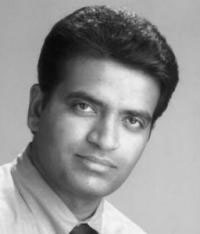| Nov 22, 2011 | |
UCSB professor receives award for graphene electronics research |
|
| (Nanowerk News) Professor Kaustav Banerjee, a professor of electrical and computer engineering and Director of the Nanoelectronics Research Lab at the University of California, Santa Barbara, has been named winner of the 2011 international research award by the Electrostatic Discharge Association (ESDA). | |
 Professor Kaustav Banerjee "The ESDA research award is highly competitive and meant to recognize cutting edge research ideas that advance the field of electrostatic discharge. Professor Banerjee's visionary proposal to investigate the electro-thermal behavior of graphene electronics is very timely and generated a lot of interest among the technical leaders in the ESD community." said Dr. Charvaka Duvvury, Texas Instruments Fellow and a Board Member of ESDA. The research award recognizes one outstanding researcher from academic institutes around the world for innovative research ideas in electrostatic discharge (ESD) prevention in integrated circuits and systems. ESD is a major reliability issue in the electronics industry, being the single largest cause of all integrated circuit failures. At an estimated annual loss of millions of dollars, ESD affects electronics industry production, manufacturing costs, product quality and reliability, and profitability, according to the ESDA. "We have already carried out some high-current measurements on the graphene devices prepared by Professor Banerjee's team and we are amazed at the current carrying capacity of a monolayer or bilayer of carbon atoms," said Dr. Harald Gossner, Senior Principal Engineering at Intel Mobile Communications. "It also indicates the high-quality of the graphene that they are able to synthesize." The award was announced during the opening ceremony of the EOS/ESD Symposium held in Anaheim, California, in September 2011, and includes a cash prize of $10,000. |
|
| "UCSB Engineering is at the forefront of graphene nanoelectronics research, thanks to Professor Banerjee's contributions," said Rod Alferness, Dean of the College of Engineering at UCSB. "The ESDA award is a clear recognition of the innovation and significance of his research in emerging nanotechnology." | |
| "Although graphene is known to sustain high current densities, there is almost no information available on the high current and electrostatic discharge behavior of graphene-based transistors or interconnects," commented Professor Banerjee. "Such studies help understand fundamental issues in these structures and open up exciting new applications in the Green Electronics arena, including their novel electrostatic discharge protection solutions." | |
| About the ESD Association (ESDA) | |
| Founded in 1982, the ESD Association is a professional voluntary association dedicated to advancing the theory and practice of electrostatic discharge avoidance. Its over 2000 members come from more than 30 countries throughout the world. To meet the needs of a continually changing environment, the Association is chartered to expand ESD awareness through standards development, educational programs, local chapters, publications, tutorials, certification, and symposia. The ESD Association also has the responsibility of representing the interest of the United States at the International Electrotechnical Commission (IEC) in the area of electrostatics. | |
| About Kaustav Banerjee | |
| Kaustav Banerjee is a Professor of Electrical and Computer Engineering and Director of the Nanoelectronics Research Lab at UC Santa Barbara. He is also an Affiliated Faculty with the California NanoSystems Institute (CNSI) and the Institute for Energy Efficiency (IEE) at UCSB. Banerjee received a Ph.D. in Electrical Engineering and Computer Science from UC Berkeley. |
| Source: University of California - Santa Barbara |
